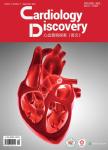Association of Remnant-like Particle Cholesterol with Major Adverse Cardiovascular Events in Subjects with Different Levels of Proprotein Convertase Subtilisin/Kexin 9:A 9.5-year Follow-up Study in a Beijing Community Population
Association of Remnant-like Particle Cholesterol with Major Adverse Cardiovascular Events in Subjects with Different Levels of Proprotein Convertase Subtilisin/Kexin 9: A 9.5-year Follow-up Study in a Beijing Community Population作者机构:Department of Geriatric CardiologyThe Second Medical Center&National Clinical Research Center for Geriatric DiseasesChinese People's Liberation Army General HospitalBejing 100039China
出 版 物:《Cardiology Discovery》 (心血管病探索(英文))
年 卷 期:2023年第3卷第3期
页 面:159-165页
基 金:supported by the National Key Research and Development Program of China (2021YFC2500604)to Li Sheng.
主 题:Cardiovascular diseases Remnant-like particle cholesterol Proprotein convertase subtilisin/kexin 9 Major adverse cardiovascular events
摘 要:Objective::The purpose of this study was to determine the relationship between remnant-like particle cholesterol(RLP-C)and major adverse cardiovascular events(MACEs)in patients with different levels of proprotein convertase subtilisin/kexin 9(PCSK9).Methods::From September 2007 to January 2009,1,859 subjects in Pingguoyuan communities in Beijing were initially screened.After excluding those with bedridden status,mental illness,severe systemic diseases,and missing data,1,680 subjects were recruited for follow up.All recruited subjects were followed up from February 2013 to September 2013(181 subjects were lost to follow-up)and from June 2017 to September 2018(174 subjects were lost to follow up).Finally,1,325 subjects were included in the study.General demographic characteristics,lifestyle and behaviors,disease history and use of medication was collected.Levels of total cholesterol,triglycerides,high-density lipoprotein cholesterol,low-density lipoprotein cholesterol,fast blood glucose,RLP-C,low-density lipoprotein triglycerides and PCSK9 were measured.The levels of RLP-C(low:RLP-C≤157 mg/L;high:RLP-C157 mg/L)and PCSK9(low:PCSK9≤135.87μg/L;high:PCSK9135.87μg/L)were represented using quartiles.Subjects were categorized into 4 groups according to their RLP-C and PCSK9 levels:Q4,high levels of RLP-C with high levels of PCSK9;Q3,high levels of RLP-C with low levels of PCSK9;Q2,low levels of RLP-C with high levels of PCSK9;and Q1,low levels of RLP-C with low levels of PCSK9.The association of RLP-C with MACEs in subjects with different PCSK9 levels was evaluated.Results::After a median follow-up of 9.5 years,1,325 subjects were included in the study and a total of 191 MACEs had occurred.The incidence of MACEs was higher in the RLP-C157 mg/L group than the RLP-C≤157 mg/L group(18.40%vs.10.42%).Cox proportional hazards regression model analysis showed that increased RLP-C levels were associated with an increased risk of MACEs(hazard ratio:1.405;95%confidence interval:1.005-1.964;P0.005).The incidence of MACEs was higher in the high RLP-C/PCSK9 group vs.the low RLP-C/PCSK9 group(20.68%vs.8.76%).Cox proportional hazards regression model analysis showed that RLP-C was associated with an increased risk of MACEs in subjects with high PCSK9 levels independent of traditional risk factors(hazard ratio:1.791;95%confidence interval:1.168-2.825;P=0.001),but not in those with low PCSK9 levels.Conclusions::RLP-C was identified as a risk factor for MACEs,particularly in subjects with high PCSK9 levels.Lowering PCSK9 levels may reduce residual risk in subjects with elevated plasma RLP-C levels.



